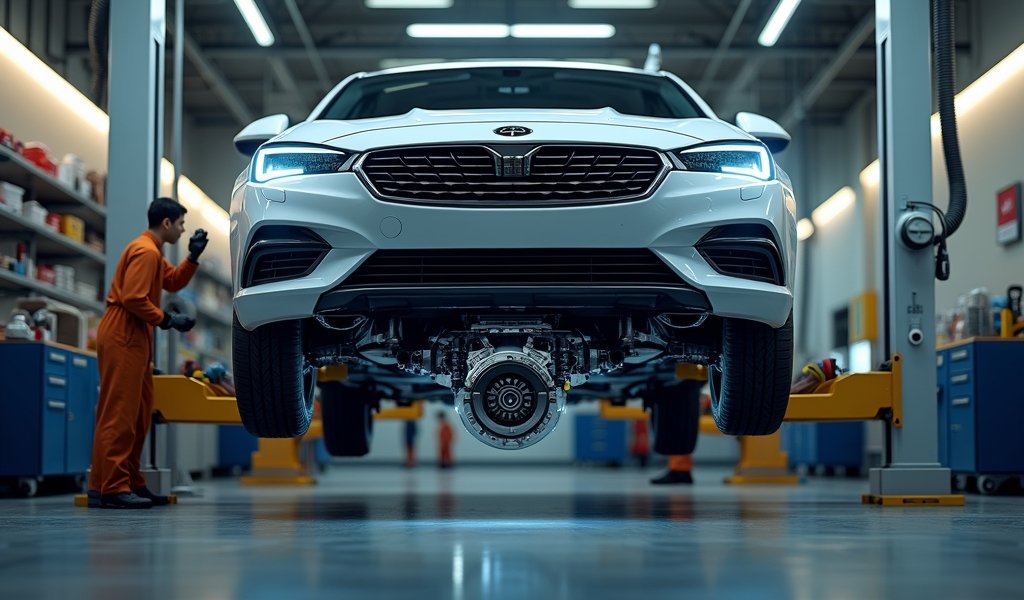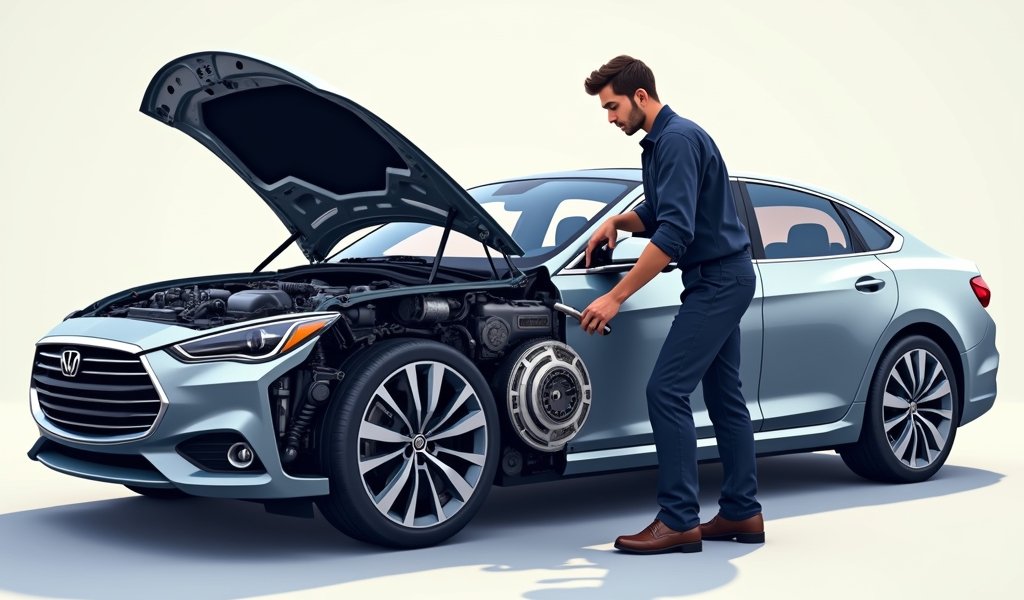Overview
This article explains that clutch replacement typically costs $700-$2,000 depending on vehicle type, parts quality, and labor rates, with key signs of clutch failure including slipping, changing engagement points, and difficulty shifting. It provides guidance on getting fair quotes from different service providers (dealerships vs. independent shops), recommends proper driving techniques to extend clutch life, and emphasizes the importance of avoiding “clutch-killing” habits like riding the clutch or using it to hold position on hills.
Table of Contents
- Understanding Clutch Replacement Costs: What Drives the Price?
- Recognizing Clutch Failure: When Is Replacement Actually Necessary?
- Getting Fair Quotes: How to Compare and Save
- Exploring Service Options: Beyond the Dealership
- Extending Clutch Lifespan: Protecting Your Investment
- Conclusion: Making Smart Clutch Replacement Decisions
- Frequently Asked Questions
Understanding Clutch Replacement Costs: What Drives the Price?
Your vehicle’s clutch is the unsung hero of your driving experience, silently transferring power from the engine to the wheels with every shift. When that smooth operation starts to falter, the dreaded clutch replacement cost can leave many drivers anxious about their bank accounts.
Having replaced hundreds of clutches throughout my 20-year career as a master technician, I can tell you that clutch replacement costs typically range from $700 to $2,000 for most vehicles. But why such a wide range? Let’s break down what really drives these prices.
The True Cost Breakdown
When we provide estimates for clutch replacements at the shop, we divide costs into two main categories:
- Parts (30-40% of total cost): This includes the clutch kit (pressure plate, clutch disc, release bearing), potentially a new flywheel, and smaller components like hydraulic parts.
- Labor (60-70% of total cost): This represents the bulk of your bill because accessing the clutch requires removing the transmission—no small task on most vehicles.
The parts themselves vary tremendously based on your vehicle. For example, a basic clutch kit for a Honda Civic might cost around $150-250, while a performance clutch for a BMW M3 could easily exceed $800 just for parts.
Vehicle-Specific Factors
Your car’s design significantly impacts how much you’ll pay for a clutch job. Here’s why:
- Front-wheel-drive vehicles typically cost 15-30% more than rear-wheel-drive cars due to more complex transmission removal procedures
- European luxury and performance vehicles often require specialized tools and parts that drive up costs
- Some vehicles (I’m looking at you, Audi TT and certain Subarus) require dropping the entire drivetrain for clutch access
- Dual-mass flywheels, common in many modern vehicles, add $300-600 to the job if they need replacement
I recently worked on a seemingly simple Ford Focus that required removing the entire front subframe to access the transmission. What might have been a 4-hour job on another vehicle turned into 8+ hours of labor!
Regional Price Variations
Geography plays a surprising role in average car service costs, including clutch replacements. Labor rates can vary by as much as $60-100 per hour between regions:
- Rural areas typically charge $75-100 per hour
- Suburban shops average $90-130 per hour
- Major metropolitan areas often command $125-200+ per hour
This regional variation alone can create a $400+ difference in the final bill for the exact same service.

Recognizing Clutch Failure: When Is Replacement Actually Necessary?
One of the most common and costly mistakes I see is drivers replacing clutches prematurely or, worse, waiting until catastrophic failure causes additional damage. Let’s explore how to recognize when you genuinely need a clutch replacement.
Telltale Signs Your Clutch Is Failing
After diagnosing thousands of transmission issues, I’ve found these symptoms to be the most reliable indicators of clutch problems:
- Slipping: Your engine revs higher without corresponding acceleration, especially noticeable when climbing hills or carrying loads
- Engagement point changes: The clutch engages much higher or lower in the pedal travel than before
- Difficulty shifting: Gears become hard to engage, especially from a stop into first gear
- Strange noises: Grinding, squealing, or chirping sounds specifically when the clutch pedal is pressed
- Burning smell: A distinctive paper-burning odor after heavy clutch use (like stop-and-go traffic or hill starts)
One clear sign I tell my customers to watch for is what I call the “rev-but-no-go” test. From a stop, with the car in first gear, slowly release the clutch. If the engine RPMs climb significantly but the car barely moves, you’re experiencing clutch slip—a key indicator of worn friction material.
Clutch Problems vs. Other Transmission Issues
Not all transmission problems are clutch-related, and I’ve saved many customers from unnecessary replacements by identifying the true culprit:
- Transmission fluid leaks typically indicate issues with seals or the transmission itself, not the clutch
- Grinding only when shifting into specific gears often points to worn synchronizers rather than clutch problems
- Difficulty shifting when cold but improvement when warm suggests transmission fluid issues
- Vibration when engaging the clutch might indicate a warped flywheel rather than a worn clutch disc
A proper diagnosis should always include a test drive and physical inspection. Any shop suggesting a clutch replacement without these steps isn’t doing their due diligence.
Understanding Clutch Lifespan
Modern clutches typically last between 50,000 and 100,000 miles, but I’ve seen tremendous variation based on driving habits and conditions. According to The American Automobile Association, driving habits influence clutch longevity more than any other factor.
Factors that significantly reduce clutch lifespan include:
- Frequent stop-and-go city driving (up to 50% reduction in lifespan)
- Regular heavy towing or hauling (30-40% reduction)
- “Riding” the clutch by resting your foot on the pedal (can reduce lifespan by years)
- Aggressive driving with rapid starts and shifts
I once had a customer whose clutch lasted 180,000 miles due to primarily highway driving and gentle shifting habits. Another customer—a delivery driver in hilly San Francisco—needed replacement at just 38,000 miles. Your mileage will quite literally vary!
Getting Fair Quotes: How to Compare and Save
When the time comes for clutch replacement, getting multiple quotes isn’t just smart—it’s essential. I’ve seen quotes for identical clutch jobs vary by as much as $800 between shops in the same city. Here’s how to ensure you’re getting a fair deal without sacrificing quality.
The Power of Multiple Estimates
Always get at least three quotes before making your decision. This approach helps you:
- Establish a realistic price range for your specific vehicle
- Identify outliers that might be overcharging or cutting corners
- Provide leverage for negotiation with your preferred shop
- Learn about different approaches and parts options
When collecting quotes, ensure you’re comparing apples to apples. A $200 difference might simply reflect that one shop includes flywheel resurfacing while another doesn’t.
Essential Questions to Ask
After decades in the industry, I recommend asking these specific questions when discussing your clutch replacement:
- “What specific symptoms lead you to diagnose a clutch problem?” (Listen for detailed explanations)
- “Which components will be replaced, and which will be reused?”
- “Will you resurface or replace the flywheel? Why?”
- “What brand of clutch components do you use, and why?”
- “What warranty covers both parts and labor?”
- “How many hours will the job take?”
The answers reveal not just pricing transparency but also the shop’s expertise. Quality shops provide clear, jargon-free explanations and don’t get defensive about their recommendations.
Red Flags in Clutch Replacement Quotes
Watch for these warning signs that might indicate potential issues:
- Quotes significantly lower than others (possibly using inferior parts or unrealistic labor estimates)
- Vague estimates with phrases like “might need additional work once we get in there”
- Refusing to provide parts brands or specifications
- Pressure tactics suggesting immediate replacement is the only option
- Unwillingness to show you the old parts after replacement
One particularly troubling tactic I’ve seen is quoting only for a “basic clutch job” when the vehicle clearly needs related components like hydraulic parts. This creates the illusion of a low price that inevitably climbs once work begins.
What a Good Quote Includes
A comprehensive clutch replacement quote should clearly detail:
- Specific parts to be replaced (clutch kit components, flywheel status, hydraulic parts)
- Parts brands and quality tiers (OEM, aftermarket, performance)
- Labor hours and rates
- Additional services like transmission fluid replacement
- Written warranty terms for both parts and labor
- Estimated completion timeline
The most transparent shops will even provide part numbers so you can research quality and pricing independently. This level of detail reflects confidence in their recommendation and pricing structure.
Exploring Service Options: Beyond the Dealership
When facing clutch replacement, many drivers automatically head to their dealership. While dealers offer certain advantages, exploring your options can lead to significant savings without sacrificing quality. Let’s examine the pros and cons of different service providers based on my two decades in the field.
Dealership vs. Independent Shop Comparison
Both dealerships and quality independent shops can successfully replace your clutch, but they offer different experiences:
Dealerships provide:
- Manufacturer-trained technicians with deep knowledge of your specific model
- Original equipment manufacturer (OEM) parts guaranteed to match factory specifications
- Specialized diagnostic equipment designed specifically for your vehicle
- Often more generous warranty coverage backed by the manufacturer
The downside? Dealership labor rates typically run 30-40% higher than independent shops, and they generally offer fewer parts options.
Quality independent shops offer:
- Often equally skilled technicians at significantly lower labor rates
- More flexibility with parts options and brands
- Typically more personalized service and direct communication with technicians
- Faster scheduling and shorter wait times
In my experience, the best independent shops employ ASE-certified technicians who previously worked at dealerships, providing dealer-level expertise at more competitive rates.
The Advantage of Transmission Specialists
For clutch replacement specifically, transmission repair specialists often provide the best value. These shops focus exclusively on transmission and clutch work, offering advantages like:
- Superior expertise from doing dozens of clutch jobs monthly
- Faster completion times due to specialized equipment and experience
- Better pricing on quality clutch components due to volume purchasing
- Greater familiarity with common model-specific clutch issues
I’ve found that transmission specialists typically complete clutch jobs 15-20% faster than general repair shops due to their specialized focus and equipment. This efficiency often translates to lower labor costs even with the same hourly rates.
Parts Options to Consider
You have several choices beyond standard OEM components:
- OEM parts: Direct factory replacements (highest cost, excellent reliability)
- Premium aftermarket: High-quality brands like Luk, Sachs, and Exedy (15-25% savings, comparable quality)
- Standard aftermarket: Budget-oriented brands (30-40% savings but potentially shorter lifespan)
- Performance upgrades: Enhanced components for better durability or performance (higher cost but potentially longer life)
For most daily drivers, premium aftermarket clutch kits from reputable manufacturers offer the best balance of quality and value. According to Motor Magazine, these components often meet or exceed OEM specifications while providing significant cost savings.
DIY Considerations
For the mechanically inclined, DIY clutch replacement might seem tempting. Before going this route, honestly assess:
- Equipment needs: Transmission jack, engine support, torque wrench, and potentially specialized tools
- Space requirements: Garage with sufficient clearance for transmission removal
- Time commitment: 8-16 hours for a first-timer, even with good mechanical skills
- Complexity level: 8/10 difficulty among common vehicle repairs
- Risk factors: Improper installation can lead to premature failure or transmission damage
In my professional opinion, clutch replacement falls into the category of repairs that are technically possible but rarely practical for DIY mechanics without professional experience. The specialized tools alone can cost more than the labor savings for a one-time job.

Extending Clutch Lifespan: Protecting Your Investment
After you’ve invested in a new clutch, proper driving habits and maintenance can dramatically extend its service life. I’ve seen identical vehicles with clutches lasting either 40,000 or 120,000 miles—the difference coming down entirely to how they’re driven and maintained.
Clutch-Killing Habits to Avoid
These common driving behaviors significantly reduce clutch lifespan:
- “Riding” the clutch: Keeping your foot resting on the clutch pedal when not shifting
- Hill holding: Using clutch friction instead of the brake to prevent rolling on inclines
- Launch abuse: Aggressive starts from a standstill with high RPMs
- Partial engagement: Driving with the clutch partially depressed (common in slow traffic)
- Speed control with clutch: Using the clutch to modulate speed instead of brakes and accelerator
The most damaging habit I see is what I call “hover foot”—drivers who unconsciously rest their foot on the clutch pedal during normal driving. Even light pressure can partially disengage the clutch, causing continuous friction and heat that dramatically accelerates wear.
Proper Clutch Technique
These simple habits can double your clutch’s lifespan:
- Keep your left foot on the floor (not hovering near the clutch) when not actively shifting
- Fully engage or disengage the clutch rather than leaving it in a partial position
- Shift smoothly without forcing the transmission into gear
- Use the parking brake (not the clutch) to hold position on hills
- Avoid unnecessary downshifting when braking to a stop
I advise new drivers to develop the habit of “decisive clutch movement.” When shifting, move the pedal purposefully and completely rather than hesitantly or partially. This single technique prevents the excessive slippage that destroys clutch surfaces.
Maintenance for Maximum Longevity
Beyond driving habits, these maintenance steps support clutch health:
- Check and maintain proper clutch fluid levels every 6 months
- Address any changes in pedal feel immediately, before major damage occurs
- Replace hydraulic fluid every 30,000-60,000 miles to prevent internal corrosion
- Adjust cable-operated clutches according to manufacturer specifications
- Avoid exceeding your vehicle’s towing capacity, which places tremendous strain on clutch components
Many drivers don’t realize that affordable auto service like regular clutch hydraulic fluid maintenance can prevent expensive repairs later. Fresh fluid prevents internal corrosion in the hydraulic system that can lead to sticky operation and premature wear.
Post-Replacement Vigilance
After installing a new clutch, pay attention to these indicators during the break-in period:
- Changes in engagement point during the first 500 miles (some adjustment is normal)
- Unusual vibrations or noises that weren’t present immediately after installation
- Increased effort required to shift, especially when the engine is warm
- Fluid leaks around the bell housing or near the master cylinder
- Return of symptoms that prompted the original replacement
A quality clutch replacement should provide smooth, consistent operation from day one, though engagement may feel slightly different as the new components seat themselves during the first few hundred miles. Any significant changes warrant immediate attention.
Conclusion: Making Smart Clutch Replacement Decisions
Clutch replacement doesn’t have to be a financial nightmare or mysterious process. With the knowledge we’ve covered, you’re now equipped to make informed decisions that can save you hundreds of dollars while ensuring quality repair that lasts.
Remember these key takeaways:
- Understand that clutch replacement costs vary significantly based on your vehicle, location, and parts choices
- Learn to recognize genuine clutch failure symptoms to avoid premature or unnecessary replacement
- Always get multiple detailed quotes and ask specific questions about the work to be performed
- Consider transmission specialists as often the best value option for clutch replacement
- Extend your new clutch’s lifespan through proper driving habits and regular maintenance
As a mechanic who’s replaced countless clutches, I can tell you that the most expensive repair is always the one that could have been avoided or the one that needs to be done twice because of poor-quality work. By following the advice in this guide, you’ll be better positioned to get the job done right the first time, at a fair price.
Your clutch is your car’s handshake with the road—make sure it’s a firm one!
Frequently Asked Questions
How long does a clutch replacement typically take?
Most clutch replacements take between 4-8 hours of labor, depending on the vehicle. Some complex vehicles with difficult transmission access can take up to 12 hours.
Can I drive with a failing clutch?
You can drive with early signs of clutch wear, but a severely slipping clutch creates safety concerns and risks additional transmission damage. Avoid towing, mountain driving, or heavy loads until repairs are completed.
What’s the difference between a clutch kit and just replacing the clutch disc?
A clutch kit includes the disc, pressure plate, and release bearing, while replacing just the disc addresses only one component. Most professionals recommend complete kit replacement since labor is the same either way.
Does my flywheel always need replacement with the clutch?
Flywheels don’t always require replacement, but should at minimum be inspected and resurfaced. Dual-mass flywheels often need replacement when showing wear, as they cannot be effectively resurfaced.
Will my new clutch feel different than my old one?
Yes, a new clutch typically has a different engagement point and may require slightly more pedal pressure. These differences become less noticeable after the break-in period of approximately 500 miles.

